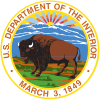Wally Hickel
Walter Joseph Hickel | |
|---|---|
 | |
| 2nd & 8th Governor of Alaska | |
| In office December 5, 1966 – January 29, 1969 December 3, 1990 – December 5, 1994 | |
| Lieutenant | Keith H. Miller (1966-1969) Jack Coghill (1990-1994) |
| Preceded by | William A. Egan (1966) Steve Cowper (1990) |
| Succeeded by | Keith H. Miller (1969) Tony Knowles (1994) |
| 38th United States Secretary of the Interior | |
| In office January 24, 1969 – November 25, 1970 | |
| Preceded by | Stewart Udall |
| Succeeded by | Rogers Morton |
| Personal details | |
| Born | August 18, 1919 Ellinwood, Kansas |
| Political party | Republican Alaskan Independence Party |
Walter Joseph "Wally" Hickel (born August 18, 1919) is an American Republican politician who was Governor of Alaska from 1966 to 1969, and again from 1990 to 1994. He resigned the governorship on January 29, 1969 to be United States Secretary of the Interior from 1969 to 1970 under President Richard Nixon.
Early life and career
Born in Ellinwood, Kansas, Hickel relocated to Alaska in 1940, going into the local real estate industry. By 1947, Hickel had formed a successful construction company. While some fellow Republicans in the Alaska Territory opposed statehood, Hickel joined Democrats in calls for joining the Union during the late 1940s and into the 1950s. Using his growing popularity among Alaskan Republicans and growing political clout in Washington, Hickel was able to travel to the nation's capital to engage in talks with key Republicans in both the U.S. Congress and within the Eisenhower Administration to speak about Alaskan statehood. Thanks in part to his efforts, Hickel's debates with Congressional leaders led to enough initially hesitant Republicans voting in favor of the Alaska Statehood Act in 1958.
Political career
First governorship
Hickel was elected as Alaska's second governor in the 1966 state general elections, defeating his Democratic rival and incumbent governor William Egan. Hickel's first governorship, the second in the young state's history as well as Alaska's first Republican governorship, oversaw the discovery of oilfields at Prudhoe Bay in 1968, a factor that would prove politically decisive in later years. Hickel, a moderate Republican and environmentalist, did not push for heavy oil exploitation.
Like his predecessor William Egan, Hickel sought to improve relations with Alaskan Natives in seeking resolutions on Native land claims.
Interior Secretary
Following Richard Nixon's win to the Presidency in late 1968, the President-elect asked Hickel to serve within the United States Cabinet as Interior Secretary. Initially, Hickel declined the cabinet offer. Nixon replied that his decision was final. Hickel would recall years later that he cried afterwards, and announced he would be resigning from the governorship to go to Washington.
Upon becoming the federal Secretary of the Interior, Hickel proved to be a strong environmentalist, supporting liberal Congressional laws that put liabilities on oil companies operating offshore oil rigs, as well as demanding environmental safeguards on Alaska's growing oil industry. His voice would ruffle other more conservative elements within the cabinet.
Hickel's centrist voice inside the Nixon Administration eventually led to confrontations with the President. In 1970 following the shooting of college students at Kent State University by the Ohio National Guard, Hickel wrote a letter critical of Nixon's Vietnam War policy and urging him to give more respect to the views of young people critical of the war. This dissent garnered worldwide media attention, and on Thanksgiving Eve 1970, Hickel was called into the Oval Office and fired over the letter.
Second governorship
In 1990, an open primary nominated Alaska State Senator Arliss Sturgulewski as the Republican candidate for Governor of Alaska, facing the Mayor of Anchorage, Democrat Tony Knowles, in the general election. Sturgulewski was criticized by many Republicans for her positions on issues such as abortion and capital punishment. Alaskan Independence Party chairman Joe Vogler seized on this discontent to offer the seats on the AIP ticket to Hickel and Jack Coghill, who had been nominated as the Republican candidate for Lieutenant Governor of Alaska. John Howard Lindauer and Jerry Ward, the previous AIP candidates, stepped aside, citing the illness of Lindauer's wife [1], and Hickel and Coghill prevailed in the general election.
Although he had common ground with the Alaska Independence Party in fighting restrictions on land use imposed by federal environmentalism, Hickel had been one of the most influential historical proponents of Alaska statehood and never endorsed the AIP's secessionism, prompting some party faithful to petition for his recall. Completing his term as Governor, he rejoined the Republican Party in April 1994.
In 2006 he supported Sarah Palin in her bid to become governor of Alaska. [2]
Hickel is also a real estate developer and chairman of Hickel Investment Company.
Impact on the creation of NOAA
This article contains weasel words: vague phrasing that often accompanies biased or unverifiable information. |
Legend inside the Washington Beltway has it that Hickel's criticism of the Vietnam War had an impact on how the National Oceanic and Atmospheric Administration (NOAA) came to be established within the U.S. Department of Commerce, rather than in the more logical agency home, the U.S. Department of the Interior -- Hickel's post during his short tenure as Interior Secretary. It was said that Nixon, in a fit of pique during the bill-signing ceremony to establish NOAA, crossed out the Interior Department's name and wrote in 'Commerce Department,' instead.


